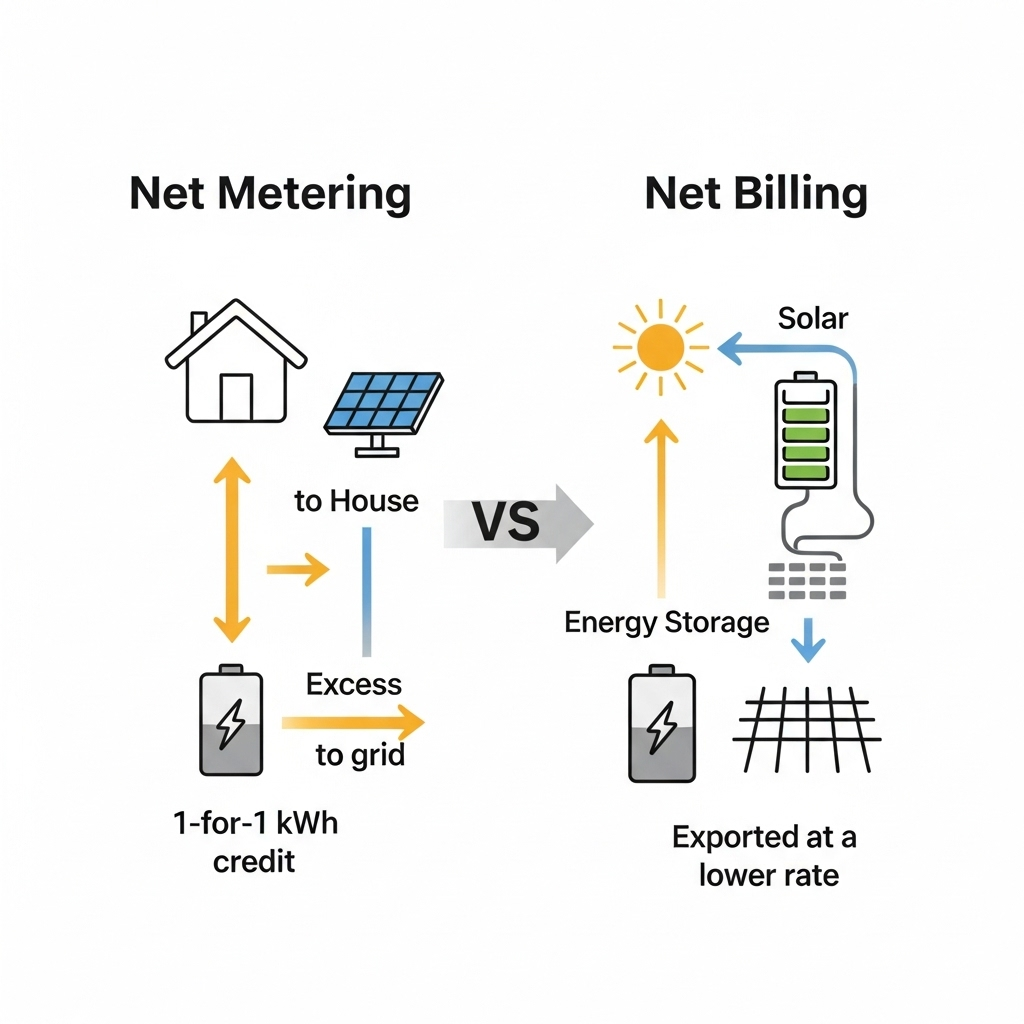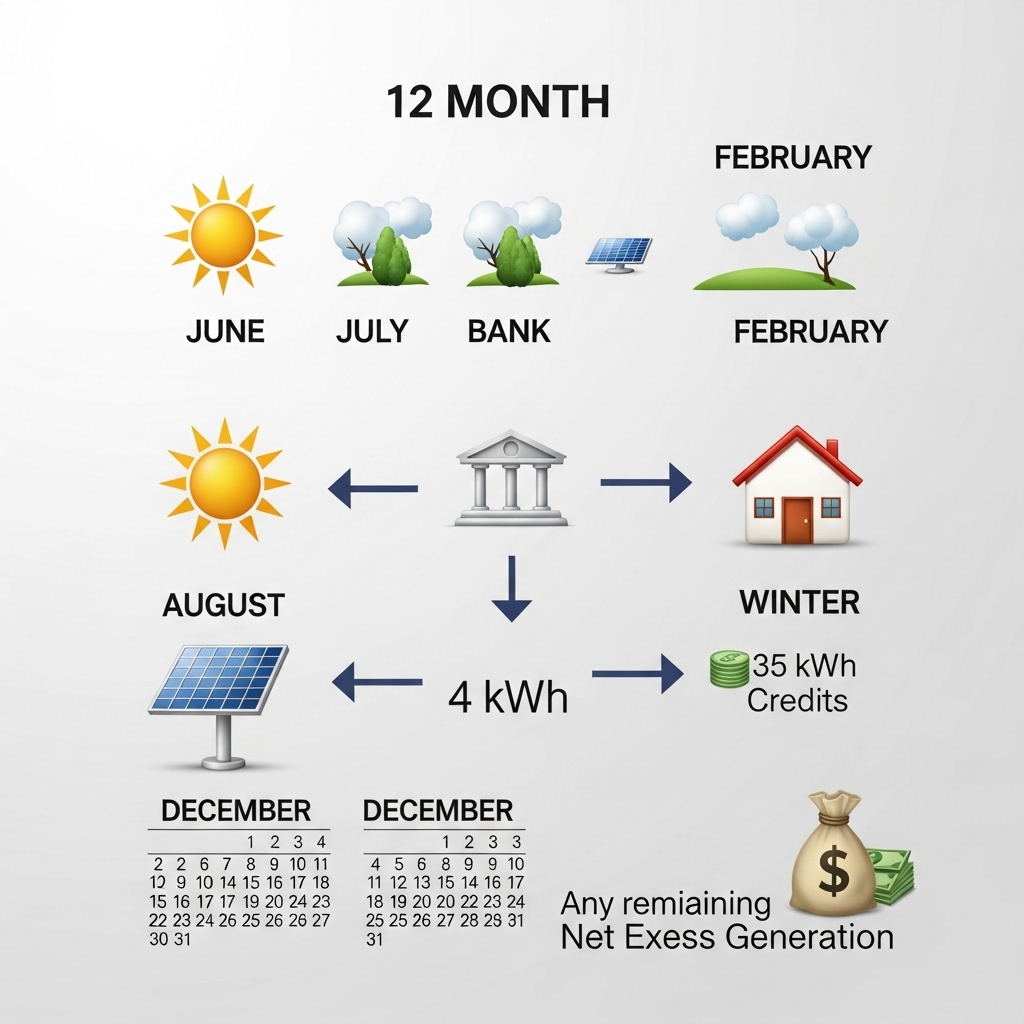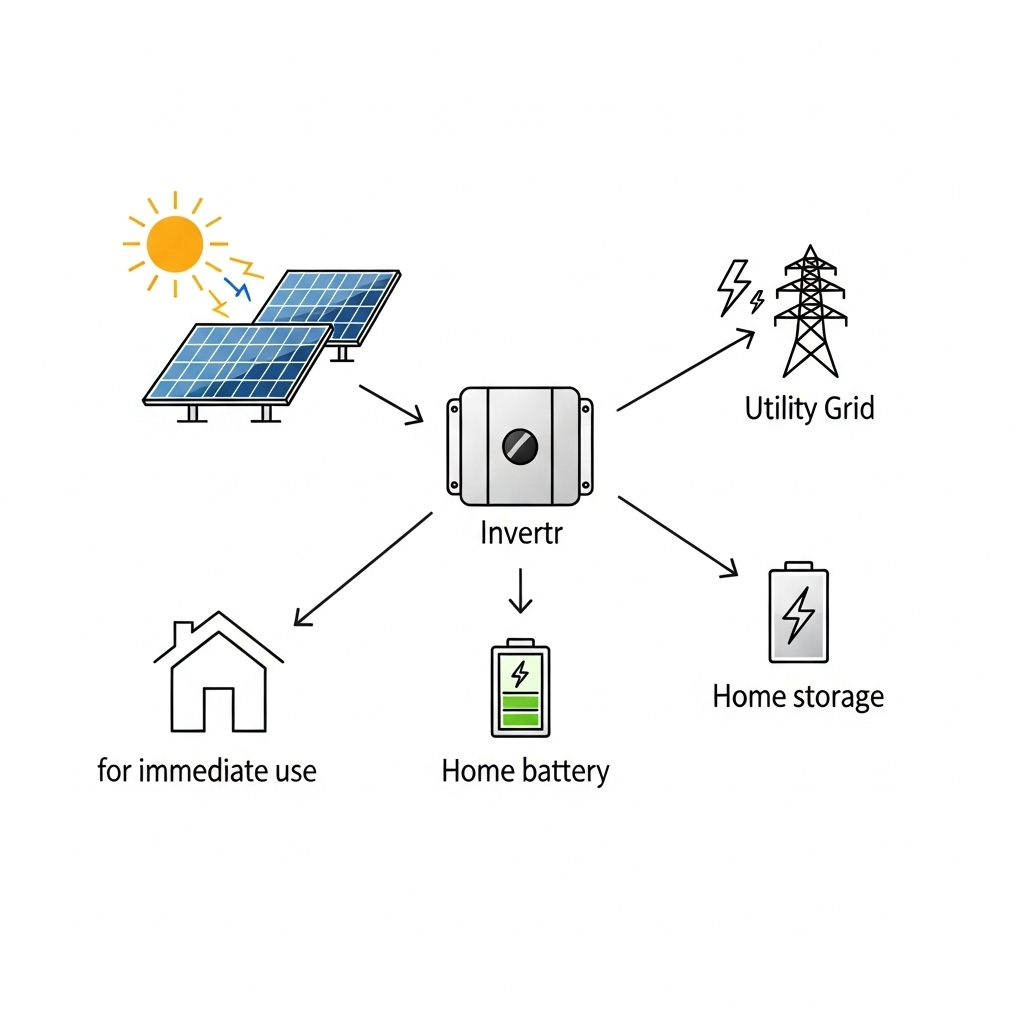You have invested in a solar energy system. Your panels are generating clean electricity from the sun. But what happens when you produce more power than your home is using at that moment? That surplus energy doesn't just disappear. It flows back to the utility grid, and how you are compensated for it is determined by a set of rules often called Export Compensation. These policies are critical because they directly influence the financial viability of your solar investment.
Understanding the differences between policies like Net Metering and Net Billing is fundamental for any solar owner. These frameworks define the value of the electricity you export. This guide provides a clear overview of these compensation mechanisms, their financial implications, and how you can adapt to a changing policy landscape to maximize your returns.
The Core Mechanisms: How You Get Paid for Your Solar Power
At the heart of solar compensation are the rules that govern the financial relationship between you and your utility company. For years, one model dominated, but as solar adoption has grown, new systems have emerged. Let's break down the most common ones.
What is Net Metering (NEM)?
Net Metering is the original, and simplest, compensation model. Think of it as a one-for-one exchange. For every kilowatt-hour (kWh) of electricity your solar system exports to the grid, you receive a credit for one kWh that you can draw from the grid later. In effect, your utility meter can spin backward when you are exporting power.
Under this system, the grid acts as a giant battery for you. You "deposit" your excess solar energy during the sunny afternoon and "withdraw" it at night or on a cloudy day. At the end of the billing period, you only pay for the "net" amount of electricity you consumed. If you exported more than you used, you might carry those credits forward. The rules for how long you can bank these credits and what happens to them at the end of the year are detailed in what's known as Net Excess Generation Rules.
The Evolution to Net Billing
Many regions are transitioning away from traditional Net Metering. The primary reason is a debate over grid maintenance costs. Critics argue that under NEM, solar owners use the grid but may not contribute fairly to its upkeep. For a deeper look into this debate, you can review discussions on Are Net Metering Credits Fair? Rethinking Network Cost Recovery.
This has led to the rise of Net Billing. The concept is straightforward: the price you pay for electricity from the grid (the retail rate) is different from the price the utility pays you for your exported solar power (the export rate). Typically, the export rate is lower than the retail rate. You buy high and sell low. This change has a significant impact on the financial calculations for a solar system, directly affecting Net Metering vs Net Billing: Impacts on ESS Sizing and ROI.
Other Compensation Models: FiT and VoS
Beyond NEM and Net Billing, two other models are worth noting:
- Feed-in Tariff (FiT): With a FiT, you are paid a specific, often premium, rate for every kWh of solar energy you generate, regardless of whether you use it yourself or export it. This model was popular for incentivizing early adoption of renewables.
- Value of Solar (VoS): This is a more complex and dynamic approach. The compensation rate is calculated based on the actual value that your exported solar energy provides to the grid at a given time. This value can include avoided energy generation costs, reduced grid congestion, and environmental benefits. It aims to create a more precise and fair pricing structure. You can learn more about how to Unlock Payback: Optimize Exports with Value-of-Solar.
Choosing between these models depends entirely on local regulations. For a full comparison, see our analysis on How to Choose Net, Gross, or Feed-In Tariffs for Rooftop PV.
Maximizing Your Solar Investment in a Changing Policy World
The shift from Net Metering to Net Billing changes the financial equation for solar owners. Simply exporting surplus power is no longer the most profitable strategy. Instead, the focus shifts to maximizing self-consumption—using as much of your own solar power as possible.
The Critical Role of Energy Storage
This is where an Energy Storage System (ESS) becomes invaluable. An ESS, which combines a battery and an intelligent inverter, allows you to store the excess solar energy you generate during the day instead of exporting it for a low rate. You can then use that stored energy during the evening and night, avoiding the need to buy expensive electricity from the grid.
A high-performance home energy storage system, built around a reliable and long-lasting LiFePO4 battery, gives you control. It empowers you to become more energy independent. With a system from ANERN, which integrates our advanced lithium batteries with a hybrid solar inverter, you can effectively create your own personal power station. This ensures you use your own clean energy first, dramatically reducing your reliance on the grid and maximizing your savings under Net Billing rules. To properly Stop Leaving Money on the Table: Align ESS with Export Rules, an integrated system is the best approach.
Calculating Your Payback Under Different Policies
Your system's payback period is directly tied to the local export compensation policy. Under Net Metering, the calculation was simpler. With Net Billing, the financial return depends heavily on your ability to self-consume.
| Compensation Policy | Strategy | Hypothetical Annual Savings (Solar Only) | Hypothetical Annual Savings (Solar + Storage) |
|---|---|---|---|
| Net Metering (1-for-1 credit) | Export all surplus power | $1,200 | $1,250 (minimal additional savings) |
| Net Billing (Export at 50% of retail) | Export all surplus power | $750 | $1,150 (by avoiding grid purchases) |
The performance of each component in your system is crucial for these calculations. For a detailed analysis of how battery depth of discharge, inverter efficiency, and other factors affect your real-world returns, our guide on Solar Storage Performance offers extensive data. The data shows that a high-efficiency inverter can increase your usable energy by 5-10%, which directly translates to greater savings under a Net Billing structure.
Leveraging Time-of-Use (TOU) Rates
Many utilities use Time-of-Use (TOU) rates, where electricity prices are higher during "peak" demand hours (like late afternoons) and lower during "off-peak" hours. A smart ESS can be programmed to take advantage of this. You can store solar energy during the day (when generation is high and rates might be low) and either use it or even export it to the grid during peak hours to earn a higher credit. This strategy is explored in 7 Export Rate Designs That Boost Solar-ESS Payback and Grid Value. Some may worry about the complexity, but modern systems automate this process, debunking myths discussed in Myth vs Reality: Do Time-Varying Export Tariffs Hurt Prosumers?.
A Look at Global Policies and Regional Differences
Export compensation rules are not universal. They vary significantly by country and even by state or utility. Understanding these regional differences is key to making an informed decision, whether you are a homeowner, installer, or policymaker.
International Policy Case Studies
Countries around the world have taken different paths. For example, Brazil's ANEEL introduced a net metering framework in 2012 for small-scale generators, which was a major step for renewable energy in the region. You can find lessons from this in our Case Study: Brazil ANEEL Net Metering and Export Credit Lessons. In contrast, India has employed a mix of net metering and gross metering, with regulations attempting to unify the approach for smaller systems. The experiences of distribution companies there provide valuable insights, as detailed in our look at Case Study: India's Net vs Gross Metering—What DISCOMs Learned.
The Evolving Landscape in Key Markets
In developed markets like the United States and Europe, the trend is a clear move away from traditional Net Metering. California's NEM 3.0 is a prominent example of a shift toward a Net Billing structure that more closely ties export compensation to the "avoided cost" to the utility. These new policies are often designed as a Blueprint: Export Compensation That Avoids DER Cross-Subsidies. Keeping an eye on the 2025 Outlook: Net Billing and VOS Tariffs Across Key Markets is important for anyone in the industry.
Navigating the Rules: From Application to Billing
The process of getting your system connected and properly compensated involves several steps. It begins with an interconnection application to your utility and ends with your monthly bill reflecting the correct credits. Ensuring compliance at every stage is vital. This process is outlined in our guide, From Interconnection to Billing: Export Credit Compliance. Accurately forecasting your returns requires a solid understanding of how to How to Model Export Compensation for Rooftop PV with Storage based on your specific local tariff structure.
Building a Resilient and Profitable Energy Future
The rules governing solar export compensation are becoming more sophisticated. The era of simple one-for-one credits is giving way to systems that better reflect the dynamic value of energy and the costs of maintaining the grid. While this adds complexity, it also creates new opportunities for savvy homeowners.
The most effective strategy in this new environment is to pair your solar panels with a robust energy storage system. This combination puts you in control. You can store your clean energy to power your home through the night, protect yourself from grid outages, and intelligently interact with the grid to maximize your financial returns.
With a reliable and scalable solution, such as an integrated system featuring high-performance LiFePO4 batteries and a smart hybrid inverter, you are not just reducing your electricity bill. You are building a foundation for true energy independence. You decide when to use your power, when to store it, and when to sell it. This is the future of personal energy management.
Disclaimer: This information is for educational purposes only and does not constitute financial or legal advice. Solar compensation policies vary widely by location and are subject to change. Consult with a qualified local solar professional and review your utility's specific regulations before making any investment decisions.





Leave a comment
All comments are moderated before being published.
This site is protected by hCaptcha and the hCaptcha Privacy Policy and Terms of Service apply.